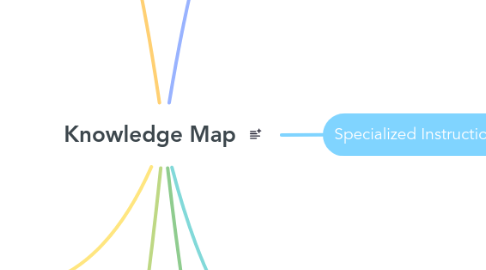
1. Vision for Future Practice
1.1. High-Leverage Practices
1.1.1. Continuously using explicit modeling and scaffolding to support student learning. Demostrating and guiding student through problem-solving steps in a math lesson.
1.2. Specialized Instruction
1.2.1. Implementing individualized education plans (IEPs) with targeted interventions to meet each students unique needs. For example using a multi-sensory approach to teach reading skills to students with dyslexia.
1.3. Professional Goals
1.3.1. 1. Continuously seek professional development opportunities 2. Collaborate with colleagues and experts to exchange knowledge. 3. Implement and refine data-driven instruction methods to ensure effective progress.
1.3.1.1. compass
2. Personal Insights and Growth
2.1. Dedication to Student Success
2.1.1. I have learned through this course that commitment to supporting diverse learners is at the core of my teaching, and I am invested in finding effective strategies to help every student succeed.
2.1.1.1. Apple
2.2. Value of Evidence-Based Practices
2.2.1. I value the importance of using research-based methods in my teaching. My approach is grounded in evidence and tailored to meet the specific needs of my students.
2.2.1.1. books
2.3. Adaptability and Creativity
2.3.1. I have also discovered that I will need to be creative and adaptable in my teaching. To find innovative ways to engage students and make learning meaningful and accessible for everyone.
2.3.1.1. crayons
2.4. Further Growth
2.4.1. Differentiated instructions: I struggle in this area, so I aim to enhance my ability to tailor lessons to meet the varying needs of my students with diverse learning.
2.4.1.1. tree
3. Assessment and Data Collection
3.1. Progress Monitoring
3.1.1. Progress monitoring allows for me as a future teacher to identify student(s) who are struggling and provide timely interventions. To allow for differentiational instructions that create an opportunity for student(s) to succeed.
3.1.1.1. bar chart
4. Core Concept and Strategies
4.1. Reinforcement: a strategy used to increase the likelihood of a desired behavior by following it with a positive consequence (positive reinforcement) or removing an aversive stimulus (negative reinforcement).
4.1.1. A teacher gives a student a sticker for completing their assignment with one prompt (positive reinforcement).
4.1.1.1. Star
4.2. Modeling: a strategy where the teacher demostrates a behavior or skill of students to observe and imitate.
4.2.1. A teacher shows student how to solve a problem on the board, then asks them to try similar problem on their own.
4.2.1.1. Monkey see
4.3. Scaffolding: providing temporary support to student as they learn new concepts or skills, gradually removing the support as they become more proficient
4.3.1. A teacher might inititally work through a math problem step-by-step with a student, then gradually reduce the guidance as the student becomes more confident.
4.3.1.1. Small Steps
4.4. Self-Monitoring: teaching student(s) to track their own behavior or performance and make adjustments as needed
4.4.1. A student uses a checklist to keep track of completed assignments or monitors their own behavior using a behavior chart.
4.4.1.1. Checklist
5. Specialized Instruction
5.1. Modification: being able to change the content, process, or product of learning to better suit the needs of the student(s) with unique learning needs.
5.1.1. In a history class, a student with a learning disability might be given a simplified version of a reading assignment or allowed to demostrate their understanding through a project instead of a written test.
5.1.1.1. Modifications are essential because they help create an inclusive learning environment where all students can succeed. They reflect a commitment to equity and the belief that every student deserves the opporunity to learn and grow.
5.1.1.1.1. Modification: https://cainclusion.org/camap/building-blocks-infographic-6-modifications-for-your-early-ed-classroom/
6. High-Leverage Practices
6.1. Explicit Instructions: Demostrating a skill or concept clearly or step-by-step
6.1.1. A teacher shows how to solve a math problem on the board
6.1.1.1. Explicit modeling provides students with a clear example to follow, reducing uncertainty and building confidence in their ability to perform the task.
6.2. Feedback: Providing specific, actionable feedbacl to guide student(s) improvement.
6.2.1. After student completes a reading comprehension exercise, the teacher provides feedback highlighting what the student did well and offering suggestions for improvement.
6.2.1.1. Feedback helps students understand their strengths and areas for improvement, promoting a growth mindset.
7. Direct and Explicit Instruction
7.1. Key Elements of direct and explicit instruction that I will use are: Establish specific, measurable goals, demostrate tasks in a structured and sequential manner, provide opportunities to practice with support, allow students to apply new skills on their own, and offering constructive feedback to guide and reinforce learning.
7.1.1. By the end of the lesson, you will be able to add and subtract fractions with like denominators.
7.1.1.1. Magnifyling glass
